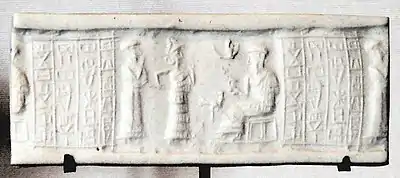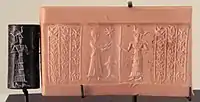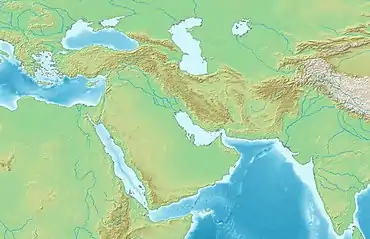Sukkalmah Dynasty
The Sukkalmah Dynasty (c. 1900-1500 BCE), also Epartid Dynasty after the founder Eparti/Ebarat,[5][6] was an early dynasty of West Asia in the ancient region of Elam, to the southeast of Babylonia. It corresponds to the latest part of the Old Elamite period (dated c.2700 – c. 1600 BC).

The Sukkalmah dynasty followed the Shimashki Dynasty (2200-1900 BCE).[7][8] The name of the dynasty comes from the name Sukkalmah meaning "Grand regents", the title used by Elamite rulers.[7]
Numerous cuneiform documents and inscriptions remain from this period, particularly from the area of Susa.[7]
The dynasty
The founder of the dynasty was a ruler named Shilhaha, who described himself as "the chosen son of Ebarat", who may have been the same as King Ebarti mentioned as the 9th King of the Shimashki Dynasty.[8] Ebarat appears as the founder of the dynasty according to building inscriptions, but later kings rather seem to refer to Shilhaha in their filiation claims.[5]
The dynasty was roughly contemporary with the Old Assyrian Empire, and the Old Babylonian period in Mesopotamia. During this time, Susa was under Elamite control, but Akkadian-speaking Mesopotamian states such as Larsa and Isin continually tried to retake the city. Notable Sukkalmah dynasty rulers in Elam during this time include Sirukdukh (c. 1850), who entered into various military coalitions to contain the power of the south Mesopotamian states; Siwe-Palar-Khuppak, who for some time was the most powerful person in the area, respectfully addressed as "Father" by Mesopotamian kings such as Zimrilim of Mari, Shamshi-Adad I of Assyria, and even Hammurabi of Babylon; and Kudur-Nahhunte, who plundered the temples of southern Mesopotamia, the north being under the control of the Old Assyrian Empire. But Elamite influence in southern Mesopotamia did not last. Around 1760 BC, Hammurabi drove out the Elamites, overthrew Rim-Sin of Larsa, and established a short lived Babylonian Empire in Mesopotamia. Little is known about the later part of this dynasty, since sources again become sparse with the Kassite rule of Babylon (from c. 1595).
Gunagi vessels
The names of Ebarat and Shilhaha, the founding members of the Sukkalmah Dynasty, have been found on the Gunagi silver vessels, inscribed in the Linear Elamite script. The Gunagi vessels were discovered recently (2004). French archaeologist François Desset identified repetitive sign sequences in the beginning of the Gunagi inscriptions, and guessed they were names of Kings, in a manner somewhat similar to Grotefend's decipherment of Old Persian cuneiform in 1802-1815.[9] Using the small set of letters identified in 1905-1912, the number of symbols in each sequence taken as syllables, and in one instance the repetition of a symbol, Desset was able to identify the only two contemporary historical rulers that matched these conditions: Shilhaha and Ebarat, the two earliest kings of the Sukkalmah Dynasty.[10] Another set of signs matched the well-known God of the period: Napirisha:[10][11]
Artifacts of the Sukkalmah
.jpg.webp) Sculpture of a lion as a fountain head, Susa, Sukkalmah period.
Sculpture of a lion as a fountain head, Susa, Sukkalmah period. Sealed tablet with a serpent god, Susa circa 17th century BCE. Inscription: "Tan-Uli, sukkalmah, sukkal from Susa and Shimashki, son of the sister of Shilhaha".[12]
Sealed tablet with a serpent god, Susa circa 17th century BCE. Inscription: "Tan-Uli, sukkalmah, sukkal from Susa and Shimashki, son of the sister of Shilhaha".[12] File:Men with daggers, Sukkalmah dynasty, 1940-1600 BCE, Susa, Louvre Museum Sb 1394.
File:Men with daggers, Sukkalmah dynasty, 1940-1600 BCE, Susa, Louvre Museum Sb 1394.
 File:Seal of Adaia attendant to Nin-Shubur, Sukkalmah dynasty, 1940-1600 BCE, Susa, Louvre Museum Sb 1418.
File:Seal of Adaia attendant to Nin-Shubur, Sukkalmah dynasty, 1940-1600 BCE, Susa, Louvre Museum Sb 1418. Cylinder seal mentionning Shilhaha, ca. 20th century B.C. Old Elamite
Cylinder seal mentionning Shilhaha, ca. 20th century B.C. Old Elamite Cylinder seal, ca. 19th–18th century B.C. Elamite
Cylinder seal, ca. 19th–18th century B.C. Elamite Reception seal, Sukkalmah dynasty, 1940-1600 BCE, Susa, Louvre Museum Sb 1440
Reception seal, Sukkalmah dynasty, 1940-1600 BCE, Susa, Louvre Museum Sb 1440
Rulers
| Name | Portrait | Title | Born-Died | Entered office | Left office | Family Relations | Note | ||
|---|---|---|---|---|---|---|---|---|---|
| Sukkalmah or Epartid dynasty,[14] c. 1970–c. 1500 BC | |||||||||
| 1 | Eparti II
|
king of Anshan & Susa | ?–? | c. 1973 BC | ? | Married with a daughter of Iddin-Dagan king of Isin in 1973 BC.[15] | cont. Iddin-Dagan king of Isin | ||
| 2 | Shilhaha
|
Sukkalmah | ?–? | ? | ? | "chosen son of Ebarat" [16] | |||
| 3 | Kuk-Nashur I | Sukkalmah | ?–? | ? | ? | son (ruhushak)[17] of Shilhaha | |||
| 4 | Atta-hushu | Sukkal and Ippir of Susa, Shepherd of the people of Susa, Shepherd of Inshushinak | ?–after 1894 BC | ?1928 BC | after 1894 BC | son of Kuk-Nashur I (?) | |||
| 5 | Tetep-Mada | Shepherd of the people of Susa | ?–? | after c. 1890 BC | ? | son of Kuk-Nashur I (?) | |||
| 6 | Palar-Ishshan | Sukkalmah | ?–? | ? | ? | ? | |||
| 7 | Kuk-Sanit | ?–? | ? | ? | son of Palar-Ishshan (?) | ||||
| 8 | Kuk-Kirwash | Sukkalmah, Sukkal of Elam and Simashki and Susa | ?–? | ? | ? | son of Lan-Kuku & nephew of Palar-Ishshan | |||
| 9 | Tem-Sanit | ?–? | ? | ? | son of Kuk-Kirwash | ||||
| 10 | Kuk-Nahhunte | ?–? | ? | son of Kuk-Kirwash | |||||
| 11 | Kuk-Nashur II | Sukkalmah, Sukkal of Elam, Sukkal of Elam and Simashki and Susa | ?–? | ? | ? | son of Kuk-Nahhunte (?) | |||
| 12 | Shirukduh | Sukkalmah | ?–? | c. 1790 BC | ? | ? | cont. Shamshi-Adad I king of Assyria | ||
| 13 | Shimut-Wartash I | ?–? | ? | ? | son of Shirukduh | ||||
| 14 | Siwe-Palar-Hupak | Sukkalmah, Sukkal of Susa, Prince of Elam | ?–? | before 1765 BC | after 1765 BC | son of Shirukduh | |||
| 15 | Kuduzulush I | Sukkalmah, Sukkal of Susa | ?–? | ? | ? | son of Shirukduh | |||
| 16 | Kutir-Nahhunte I | Sukkalmah | ?–? | c. 1710 BC | ? | son of Kuduzulush I | |||
| 17 | Atta-Merra-Halki | ?–? | ? | ? | son of Kuduzulush I (?) | ||||
| 18 | Tata II | Sukkal | ?–? | ? | ? | brother of Atta-Merra-Halki | |||
| 19 | Lila-Irtash | ?–? | ? | ? | son of Kuduzulush I | ||||
| 20 | Temti-Agun | Sukkalmah, Sukkal of Susa | ?–? | ? | ? | son of Kutir-Nahhunte I | |||
| 21 | Kutir-Shilhaha | Sukkalmah, Sukkal | ?–? | ? | ? | son of Temti-Agun | |||
| 22 | Kuk-Nashur III | Sukkal of Elam, Sukkal of Susa | ?–? | before 1646 BC | after 1646 BC | son of Kutir-Shilhaha | |||
| 23 | Temti-Raptash | ?–? | ? | ? | son of Kutir-Shilhaha | ||||
| 24 | Shimut-Wartash II | ?–? | ? | ? | son of Kuk-Nashur III | ||||
| 25 | Shirtuh | King of Susa | ?–? | ? | ? | son of Kuk-Nashur III | |||
| 26 | Kuduzulush II | Sukkalmah, King of Susa | ?–? | ? | ? | son of Shimut-Wartash II | |||
| 27 | Tan-Uli | Sukkalmah, Sukkal | ?–? | ? | ? | ? | |||
| 28 | Temti-Halki | Sukkalmah, Sukkal of Elam and Simashki and Susa | ?–? | ? | ? | son of Tan-Uli | |||
| 29 | Kuk-Nashur IV[18] | Sukkalmah | ?–? | ? | ? | son of Tan-Uli | |||
| 30 | Kutik-Matlat[19] | ?–? | c. 1500 BC | ? | son of Tan-Uli | ||||
References
- The Royal City of Susa: Ancient Near Eastern Treasures in the Louvre. Metropolitan Museum of Art. 1992. p. 114. ISBN 9780870996511.
- "Site officiel du musée du Louvre". cartelfr.louvre.fr.
- Potts, D. T. (1999). The Archaeology of Elam: Formation and Transformation of an Ancient Iranian State. Cambridge University Press. p. 147. ISBN 9780521564960.
- Harper, Prudence O. (1992). Royal City of Susa: Ancient Near Eastern Treasures in the Louvre. The Metropolitan Museum of Art. p. 114.
- Carter, Elizabeth. Elam survey of political history and archaeology. University of California Press. p. 26.
- Bryce, Trevor (2009). The Routledge Handbook of the Peoples and Places of Ancient Western Asia: The Near East from the Early Bronze Age to the fall of the Persian Empire. Routledge. p. 221. ISBN 9781134159079.
- Sigfried J. de Laet; Ahmad Hasan Dani (1994). History of Humanity: From the third millennium to the seventh century B.C. UNESCO. p. 579. ISBN 978-92-3-102811-3.
- Álvarez-Mon, Javier; Basello, Gian Pietro; Wicks, Yasmina (2018). The Elamite World. Routledge. p. 289. ISBN 9781317329831.
- Desset, François (2018). "Nine Linear Elamite Texts Inscribed on Silver "Gunagi" Vessels (X, Y, Z, F', H', I', J', K' and L'): New Data on Linear Elamite Writing and the History of the Sukkalmaḫ Dynasty". Iran. 56 (2): 140. ISSN 0578-6967.
- Desset, François (2018). "Nine Linear Elamite Texts Inscribed on Silver "Gunagi" Vessels (X, Y, Z, F', H', I', J', K' and L'): New Data on Linear Elamite Writing and the History of the Sukkalmaḫ Dynasty". Iran. 56 (2). ISSN 0578-6967.
- Desset, François (CNRS Archéorient of Lyon) (2020). "Breaking The Code. The decipherment of linear Elamite, a forgotten writing system of Ancient Iran (3rd millenium BC)". www.canal-u.tv.
- Harper, Prudence O. (1992). Royal City of Susa: Ancient Near Eastern Treasures in the Louvre. The Metropolitan Museum of Art. pp. 117–118.
- Harper, Prudence O. (1992). Royal City of Susa: Ancient Near Eastern Treasures in the Louvre. The Metropolitan Museum of Art. p. 115.
- Cameron, 1936; The Cambridge History of Iran; Hinz, 1972; The Cambridge Ancient History; Majidzadeh, 1991; Majidzadeh, 1997; Vallat, "Elam ...", 1998.
- Vallat, "Elam ...", 1998.
- F.W. König. Die elamischen Königinschriften. Graz, 1965"
- "Ruhushak" means son of sister but probably it refers to a dynastical marriage between siblings. See Vallat, "Elam ...", 1998.
- Potts, 1999.
- Cameron, 1936.
Sources
- Cameron, George, "History of Early Iran", Chicago, 1936 (repr., Chicago, 1969; tr. E.-J. Levin, L’histoire de l’Iran antique, Paris, 1937; tr. H. Anusheh, ایران در سپیده دم تاریخ, Tehran, 1993)
- Potts, D. T., The Archaeology of Elam, Cambridge University Press, 1999.

